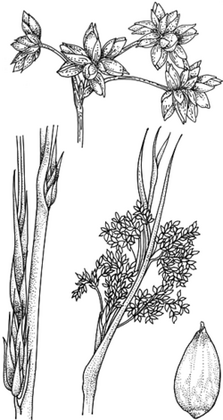Cladium procerum S.T.Blake APNI* 
Description: Big rhizomatous perennials, forming big clumps.
Culms ± terete, smooth, glabrous, 1–2.5 m high, 5–10 mm diam., often branching at nodes.
Leaves with blade to 2.5 m long, 5–20 mm wide; sheath yellow-brown at base, dull. Inflorescence big, interrupted-oblong in outline, 18–35 cm long, 6–9 cm diam.; involucral bracts longer than inflorescence. Spikelets often with only the lower flower bisexual, 3–5 mm long. Glumes 5 or 6, obtuse to acute, shorter than fertile, red-brown, glabrous, about 4 lowest empty; fertile glumes 3.5–4.0 mm long. Anthers 1.8–2.2 mm long. Style 3-fid; style base inconspicuous at maturity.
Nut ellipsoid to ovoid, 2.0–2.5 mm long, 1.3–2 mm diam., glabrous, smooth, shining, mid-brown, with basal disk inconspicuous and often remaining with spikelet.
Flowering: spring.
Distribution and occurrence: Grows in coastal swamps and margins of lakes; sporadic. Mainly along the coast, but extending inland to the Goulburn River Gorge, where it grows out of seepage lines in the sandstone rock face.
NSW subdivisions: NC, CC, SC, CWS
Other Australian states: Qld Vic. S.A. N.T.
Text by K. L. Wilson (1993); edited KL Wilson (July 2009)
Taxon concept: Flora of NSW 4 (1993)
APNI* Provides a link to the Australian Plant Name Index (hosted by the Australian National Botanic Gardens) for comprehensive bibliographic data
***The AVH map option provides a detailed interactive Australia wide distribution map drawn from collections held by all major Australian herbaria participating in the Australian Virtual Herbarium project.
|


